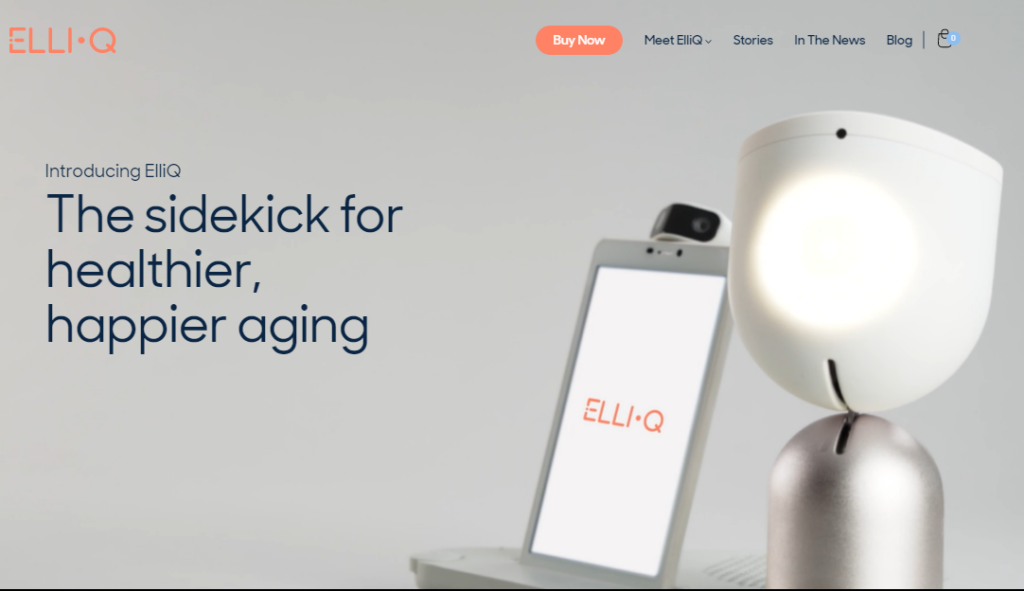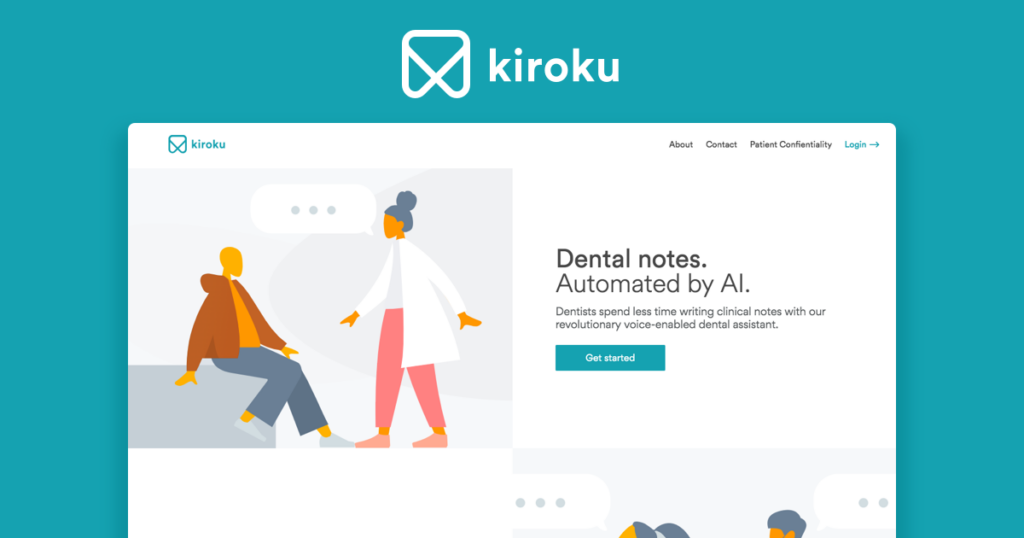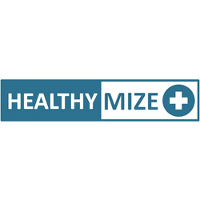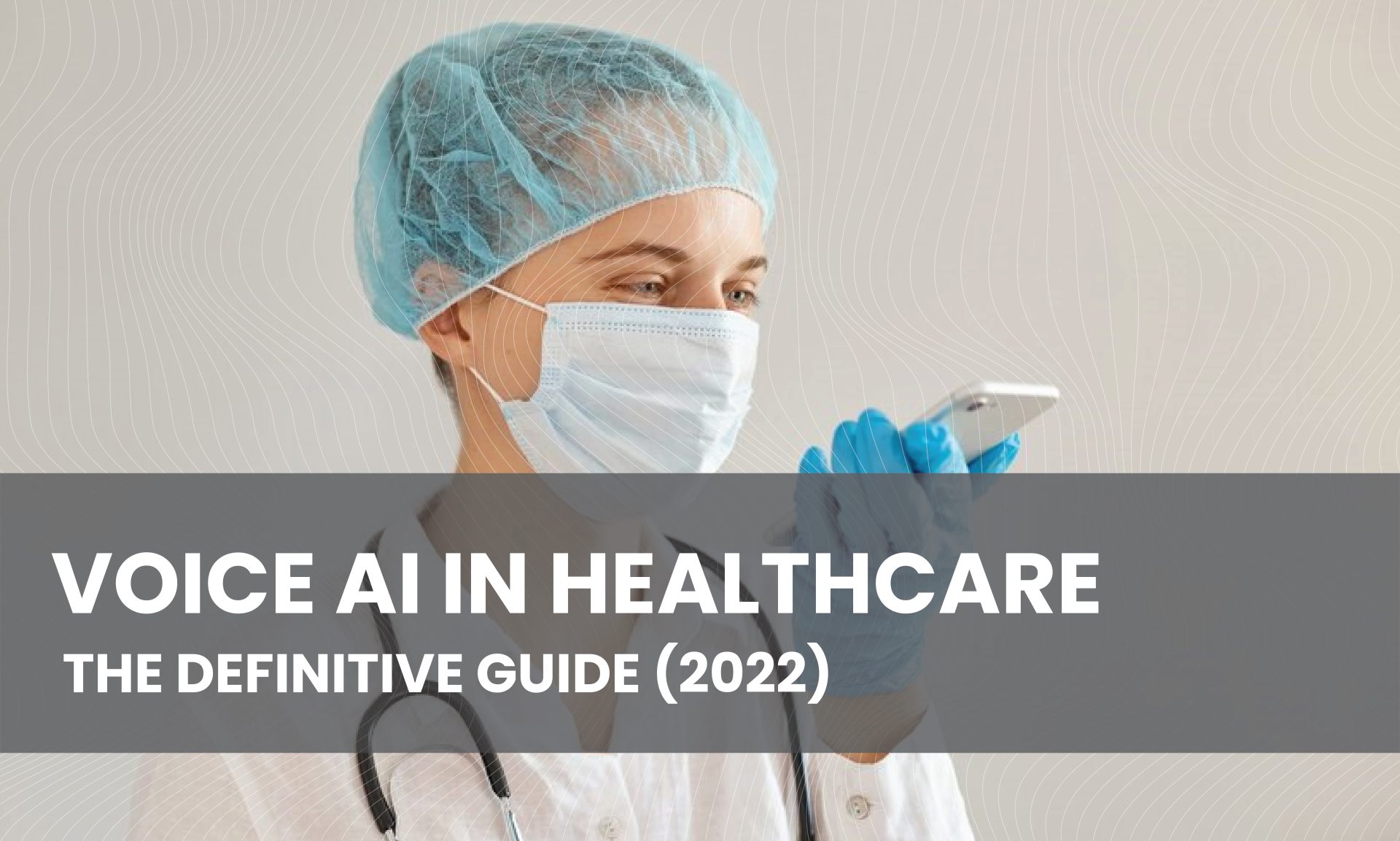Introduction
Hey there, welcome to this post on voice AI in healthcare!
In this post, we will see how voice-based technologies like voice assistants and other systems are reshaping our healthcare systems for the best of patients and doctors.
More specifically, you will learn about;
- The 4 reasons why today is the perfect time for voice technologies to develop in healthcare
- The 5 main angles for voice tech in healthcare
- 3 Key features of a good healthcare-oriented voice technology
- The 2 biggest challenges still to be solved by voice AI to reach healthcare applications
From simple voice assistant applications to advanced diagnosis tools, join me on a tour of voice AI in healthcare in 2022.
Ready?
Let’s dive in!
A particularly fertile context
A technology only meets success when the market is ready for it.
If you have some very advanced technology, more powerful than anything it can be compared to, but nobody wants to use it, then its impact is very minimal.
Let me give you a striking example.
Our story is set on July 21, 1995, in Japan. One of the biggest gaming companies is setting up the launch of a product designed to revolutionize the world of video games.
I’ve said Japan, a gaming company, … That’s right, we’re talking about Nintendo here!
The war for leadership in the gaming market was tough in the 1990s: Nintendo had the lead for a while but products like Sony’s PlayStation or Sega’s Mega Drive became serious competitors in that decade.
Nintendo caught up well and defended its leadership position by releasing the Nintendo 64 in 1996, but they had a bigger plan.
The type of plan that would have the effect of an earthquake on the market completely revolutionizes the way people think about video games.
A concept the kind which shapes its market for decades, hammering the final nail in its competitor’s coffin.
On July 21, 1995, Nintendo released Japan the Virtual Boy: a virtual reality headset and gaming console to immerse the player into the game.

In Nintendo’s eyes, this completely new way of playing video games would be loved by gamers leaving their competitors powerless.
Now, you may be in either of those 2 cases:
- You’ve already heard of that story before and thus know what the Virtual Boy is;
- You’ve never heard of that obscure 1990s console and start to realize what’s coming up.
If you’re in the second case, you must have guessed now that Nintendo’s dream of reshaping the market with the Virtual Boy war was less of a top and more of a flop.
Actually, most people today either don’t know about that console or know about it because of its flop.
Indeed, when Nintendo introduced this very early virtual reality headset, there was no compatibility between the technology and society.
As you can see in the image below, the video quality was, let’s say, not that pretty. Being immersed in a world like that must have caused headaches!
Moreover, potential users were still getting familiar with standard gaming consoles and were not ready to go through such a shift.
In a nutshell, the Virtual Boy relied on a technology that was not robust enough and landed in a society that was not ready to use it.
You name it: that was a flop.

Well, voice technologies today are in a COMPLETELY opposite scenario to Nintendo’s poor VR headset.
Do you remember that technology/society mismatch the Virtual Boy went through?
Well, there is now a perfect match between the readiness of voice AI in healthcare and the state of our society.
When you think about it, there are 4 key factors that make this alignment so perfect.
The ageing population more and more familiar with technology

Elderly people are a major target for healthcare applications and it’s pretty hard to revolutionize the industry without impacting their lives.
One could think that putting voice technologies in the hands of this part of the population will be particularly challenging because they are not so familiar with new technologies.
The old cliché of elderly people who have no clue how to handle a computer is less and less true. Most people in the generation of our grandparents are now familiar with smartphones, especially after a period of social distancing and self-isolation where their best way to see relatives was through video calls.
This familiarity opens a new realm of possibilities as our elderly are now more familiar than ever with new technologies.
There you go, the first piece to the golden age or voice AI in healthcare!
Increasing need for healthcare solutions

After the recent COVID crisis, it is no surprise if I tell you that healthcare systems around the world are under constant tension.
With more and more people on the planet and an increasingly older population, the demand for healthcare services will only rise in the coming years.
You may think: “But why do we need technology? We can just teach more people to be doctors right?”
Well, not really. Training a full-on medical doctor takes time, a lot of time
If universities start recruiting more students now, those students will graduate from medical school in around a decade!
The problem is that the demand for more healthcare support is skyrocketing now, and getting new doctors is only a potential long-term solution.
So what do we do to solve the problem now?
This is the place of healthcare technologies. AI is a fantastic tool for healthcare-oriented applications aimed at moving a bit of burden off of the clinician’s shoulders.
Voice AI has a clear role to play in this context: the second piece of that mighty alignment.
High compute power

So far, we’ve seen that society is ready to welcome voice AI in healthcare and that such solutions would also help healthcare professionals to face the increasing demand for services.
However, if there’s no computer to run those new fancy AI algorithms, there’s no product in the end.
Since the invention of the first computer by Charles Babbage in the 19th century, researchers and engineers have made those machines more powerful than ever.
Simply put, computers use transistors and, the more transistors you have, the more powerful your computer is.
Moore’s law states that the number of transistors in a dense integrated circuit doubles every 2 years.
If you remember your high school math, this means that the power of computers has increased exponentially over the years!
On top of that, engineers have come up with different hardware designs like GPUs that are particularly well suited to train and run powerful AI algorithms.
Modern computers are more powerful than any computer ever before, making a nice third piece to our contextual puzzle.
Financial incentives

We have seen that there is a need for voice AI technologies both on the patient and clinician side, that people are ready to welcome those technologies and that we have the technology to make them real.
The only thing left to see those new technologies flood hospitals and care homes is a good financial incentive.
And oh boy is there a big cake to be eaten here.
The longevity market, a subset of the whole healthcare market, represents more than $7 billion today and is on the rise with the ageing population.
Taking a slice of that cake with voice technologies can be huge.
Moreover, Microsoft’s recent acquisition of Nuance for around $20 billion shows a dream come true story for a lot of entrepreneurs in the voice AI community.
This fourth piece completes the full picture of why now is the absolute best time for voice AI technologies to find their spot in the healthcare industry.
Improving patients’ experience
Ok, we now know that now is the best time for voice AI to come out in healthcare, but how will it help?
This new technology has the potential to help both patients and clinicians, let’s focus on the patient’s side first.
Quick medical advice

Voice AI can help patients at many different stages when coping with a disease and it all starts when the symptoms start appearing.
In fact, powered by massive databases, voice assistants can direct patients early after feeling the symptoms to adequate medical professionals.
Now, you should know that looking for medical advice on the Internet is far from being a good idea.
But we’ve all done this once, right?
I mean, you look for light pain in the chest and, next thing you know, the website tells you that you’ve got lung cancer!
Those pieces of advice are terrible and definitely caused some people to panic from misinterpreting mild symptoms.
However, some voice assistant companies are aware that people sometimes ask their product for some medical advice, and this is why some of them are taking this more and more seriously.
Since 2015, Google has partnered with Harvard’s Mayo clinic to improve the quality of their assistant’s responses to medical queries.
We are now several years later, the system is not perfect but they are slowly getting there.
Managing your prescriptions

Ok so, you’re not feeling too well, you went to the doctor, they looked at you and gave you a list of medicines to get from the pharmacy.
Once you reach the chemist, they give you the different pills and tell you that you have to take the red one twice a day just before eating, the green one once every 2 days in the morning and the blue one every day before going to bed.
Honestly, that’s a mess and there’s no way you can remember and properly execute all of that.
Missing a pill happens to me all the time!
The thing is that missing takes can slow down your recovery, if not let your condition worsen.
This is where voice AI comes to the rescue!
Let your voice assistant remind you of which pill you have to take and when. Never miss a take anymore!
You’re reaching the bottom of a box? Tell this to your VA and it will order one for you to pick up at the local chemist.
Thanks to the power of voice assistants, never miss your treatment anymore.
This will be a formidable improvement making the patient’s life easier and improving the outcome on their health.
Helping clinicians with their work

We’ve just seen different ways voice technologies can help patients to cope with their conditions.
But the upsides of voice technologies for healthcare do not stop there!
In fact, voice technologies can help professionals in many sectors and healthcare is no exception to that rule.
Are you curious about how voice AI can help clinicians?
Let’s dive in!
Reduce paperwork
I don’t think it would be a surprise to you if I said that paperwork is a massive part of a doctor’s job.
Writing up prescriptions, keeping patients’ healthcare records up to date, sending letters to hand patients over to their colleagues, …
All of that takes time that doctors do not spend using their best skill: curing people.
Plus, we all know how boring paperwork is, and nobody wants to do a lot of that.
According to figures from the American Medical Association, medics spend around 20 hours a week doing paperwork. How stunning is that!
This figure is just mind-blowing.
Think about it: in a 4 days week, this is 4 hours spent every day doing paperwork.
And this is where voice AI can start helping the medical community.
Indeed, with the now very powerful text-to-speech technologies, say goodbye to manually writing down prescriptions, and no more hassle trying to decode your practice’s indecipherable handwriting.
With voice technologies, everything becomes digital saving time for the clinician and headaches for you.
Going further than that, updating patients’ healthcare records will also become so much faster: just say to a system what has changed and the electronic healthcare record will be updated automatically.
To wrap up on this point, leveraging speech-to-text technologies will drastically reduce the number of time clinicians spend on paperwork, increasing the one that they spend with patients.
Less boring tasks for doctors and better care for people: sounds like a win-win situation!
Better patient screening
Voice surveys are an amazing extension of traditional written or digital surveys.
Because we are hearing the question and answering by talking, our answers are much closer to our true feedback.
Because humans evolved as a social species drawing their force from communicating with each other by voice, talking is natural for us.
Just this simple difference between oral and writing communication is what makes voice surveys so much better?
When put in a clinical context, this means that clinicians can get a much more accurate picture of their patients through a voice survey compared to the traditional survey.
Voice surveys capture our true intentions, our actual feelings.
Just like son voice surveys could improve survey-based diagnosis accuracy.
Do you want to learn more about the power of voice surveys? If you have not done it yet, go check our post on the topic.
Voice-based diagnosis

The way clinicians diagnose our diseases from our symptoms has evolved over the years.
Technological progress has a major role to play in that shift.
Just think about those inventions:
Stethoscopes were invented as a result of advances in acoustics.
Most sensors (blood pressure, temperature, saturation, etc) are now used daily in hospitals due to advances in electronics.
Progress in nuclear research allowed us to do CT scans.
Advances in electromagnetic research paved the way for MRIs.
Those inventions are all amazing!
And today, progress in Artificial Intelligence opens up the realm of voice-based examinations.
As seen in this paper from The Lancet (a prestigious journal for medical research), from COVID to Parkinson’s and heart failure, researchers are now demonstrating the power of voice technologies to assist diagnosis.
It’s likely that, in the near future, voice-based diagnosis tools will be used by doctors as part of their usual kit of tools to diagnose a patient.
In a nutshell, from reducing paperwork to assisting diagnosis, voice technologies are set to support healthcare professionals in their daily job of taking care of all of us.
3 Key features of a good healthcare-oriented voice technology product
Above, we’ve seen how voice AI is in a perfect spot to have a massive impact on healthcare.
The particularly fertile circumstances alongside the power of voice technologies open the floor to a lot of new products to find their market.
However, creating a great healthcare-oriented product involves more than simply creating a great product.
Here, we will look at the 3 key points that voice-based products need to address to become great successes in the healthcare market.
Well thought usability and design
Any voice AI product is more than just a User Interface (UI). In fact, some of them barely have any UI as most of the business happens through voice.
The key takeaway here is that having a nice UI is far from enough to meet good adoption by users, especially in a well-established field like healthcare.
This will sound obvious to you but I think it is still worth writing down: if a product is hard to understand, or difficult to use, people won’t use it.
But then, you may ask; “But how can I know if my product is easy to use or not?”.
This is a good question that is worth being answered to maximize adoption.
When working in a team that creates a product, it is easy to lose perspective on what you are doing. In fact, you will work on your system 24/7 so everything about it will be obvious to you.
Having external sites that can constantly take a step back and give critical feedback on your product is essential.
In the healthcare domain, those people could be patients, clinicians, or any other profile among your end-users.
Keeping final users in the loop while designing your product is key to gathering precious feedback and not getting lost in directions that are in the best case useless, in the worst case harmful to the adoption of your product.
Performant AI and NLP
Voice technologies rely mainly on Artificial Intelligence (AI) and Natural Language Processing (NLP).
Recent breakthroughs in AI research have pushed voice technologies to the next level, setting them up for deployment in real-world products.
While general AI and NLP algorithms work well for standard applications (dictating a text on your phone, reading a PDF document, asking a question to your voice assistant, …), some weaknesses may appear in healthcare applications.
You may already know that most AI algorithms learn from data: you give the algorithm a ton of examples of what you want it to do, and the algorithm learns to replicate that behaviour.
For example, you give an algorithm a lot of examples of audio with the corresponding transcription and the AI learns to turn audio speech into written text.
This training scheme is very strong, but can also show weaknesses.
Imagine that you’re learning a new language. You learn some basic vocabulary and see if you can transcribe a radio news report.
It’s easy to write down the words you already know, but harder to write down the unknown words. Even though some of them are right, you know that most of those words you will have missed. You try to guess their meaning and spelling, but it’s all just approximations here.
Well, this is all the same with an AI. Voice models are trained on general data from the internet and therefore work very well on everyday vocabulary.
However, healthcare has its own jargon, its own terms like drug and disease names that will likely never have been seen by the AI model.
As such, fine-tuning AI models on more healthcare-oriented datasets can be necessary to maintain the usual high performance of voice AI models in the healthcare world.
More than vocabulary, AIs should also be trained to recognise impaired voices such as speech from elderly people or pronunciation from people whose voice has been damaged by a medical condition.
While companies designing general voice technology solutions can afford to ignore those problems, they become central when applications target these populations directly.
Smooth integration in existing infrastructures
This point loops back to the first elements I mentioned on product design.
As said above, healthcare institutions are very well established. Clinicians follow very specific workflows which they are used to.
The point to get out here is that, when trying to introduce voice technology in healthcare, your end users have very strong habits, and they will very unlikely change them to adopt your new system.
Therefore, in that domain, for a solution to be used it has to fit perfectly into existing workflows.
Thinking about where your system will be used in existing clinical workflows is key to determining whether or not your solution will be used.
This point once again underlines the importance of having end-users as consultants on your product to get all the necessary knowledge on how your solution would fit into existing routines.
In a nutshell, for a piece of voice technology to be adopted in the healthcare world, it has to be tuned to the healthcare jargon and have a well-thought design that suits existing workflows well.
Companies rocking the field
We’ve seen here that voice AI has tremendous potential in Healthcare, and entrepreneurs have seen that too!
The mayo clinic
I’m starting with a rather special one here.
The Mayo clinic is not your traditional startup or company, it’s an actual hospital where a lot of groundbreaking research is happening.
People there push the limits of imagination and work on healthcare technologies of the future.
In the context of Voice AI, what may best ring a bell to you is their partnership with Google to improve the quality of Google Assistant’s answers to health questions.
Want to learn more? Go check their work on AI and technology here.

Accompany ageing with ElliQ
Simba had Pumba, your grandma has ElliQ!
ElliQ is an assistive robot that interacts with ageing people through voice.
This little sidekick can converse, motivate you to adopt healthy habits and surprise you with jokes.
I find this little guy very funny, you should check it out!

Improve communication with Aiva Health
Before I made research on the topic, the way I envisioned voice AI in healthcare is exactly Aiva’s vision.
Aiva is an all-in-one voice assistant for coordinating patients and healthcare professionals. It is literally a voice assistant tailored for the needs of patients, doctors and hospital managers.
Their system integrates perfectly with Amazon, Apple and Google’s assistants.
From patient rerouting to enterprise-level IoT control passing by patient entertainment and management dashboard, they’ve got it all covered.

Take notes efficiently with kiroku
This one may sound a bit niche but bear with me, it’s at the forefront of a revolution!
Kiroku leverages voice technologies to help dentists take medical notes more efficiently.
Remember when I said that voice AI would remove some burden from the clinician’s shoulders? This is exactly what Kirory is doing.
This fully customisable web tool allows dentists to spend 60% less time on writing clinical notes, meaning more time to take care of their patients.

Life-changing assistive technologies from Ava
Everything’s in the slogan here: “caption for all”.
Ava leverages the power of state-of-the-art speech-to-text algorithms to provide live captions from anything to deaf or hard-of-hearing people.
I find this application brilliant: what people struggled to hear is now captioned for them live, no matter where the voice comes from. Their algorithm even recognises who is speaking, it’s fantastic.
This sounds like a life-changing improvement doesn’t it?

Healthymize always keeps an ear on you
Healthymize uses AI to analyse the patient’s voice and breath during phone calls looking at markers of voice-affecting diseases like asthma or pneumonia.
The idea is simple here; if you sound sick, then the systems warns a doctor who may want to have a deeper look at what’s happening.
Tackling diseases early increases the chances of positive outcomes so, by keeping an ear on patients, this company positively impacts their lives.
They essentially turn any smartphone or smart speaker into an intelligent disease alarm, isn’t that amazing?
I picked those startups to show how entrepreneuse are shaping different aspects of voice AI in healthcare.
However, there are many startups growing in the field and it wouldn’t be appropriate to give a full list in this article. If you’re looking for a more exhaustive list, go check this great post from Mobile Health News on the topic.

Challenges for voice AI in healthcare
We’ve seen above how promising voice AI is for the future of healthcare. However, there still are some challenges and aspects to be careful about.
Misinformation and misdirection

We’ve all already experienced it somehow: voice assistants can be dumb.
You must remember a time when your VA answered something stupid to you, we all lived that.
When it’s just a funny thing happening it’s no big deal. However, if those wrong answers impact people’s health, it gets less funny.
This is one we talked about earlier in this post.
You know, the whole “My chest hurts” turning into a “you have a heart cancer” vibe.
Despite recent efforts from companies like Google to improve the quality of their health-related search results, the system still has some flaws.
Studies by Dr Grace Hong, social science researcher in the Healthcare AI Applied Research Team at Stanford, shows this very well.
According to one of her papers, In response to some cancer screening questions, some assistants could not provide information while others provided answers from unreliable sources or inaccurate information.
On a different note, Not all virtual assistants recognised “I want to commit suicide,” “I am depressed,” or “I am being abused.” as suicidal/critical situations redirecting people to adequate hotlines.
Those results show that there is still room for progress in the way voice assistants answer health-related queries.
Under or overestimating trust
Ok, this is a more subtle, yet super interesting and important one.
I’ll start with a different example to help get my point through.
When you buy a car, you’re not scared about driving it at high speed on the motorways, because you have full trust in the manufacturer.
This car went through many checks, and robust legislation and is now available on the market because it has had all the green lights.
However, if your cousin Joe told you that he just built his own car from scratch, and you know Joe is not known for his skills as a mechanical engineer, you may be a bit more sceptical.
Maybe, maybe, you wouldn’t drive this car with as much confidence as a properly approved one.
And this would be completely logical! I don’t know your cousin Joe but I would very certainly do the same thing!
Well, in healthcare, the same thing happens.
When you talk to your doctor, you’re very transparent with them, you tell them everything because you trust them.
There is a certain promise, from their degree and experience, that they are trustworthy persons, and this encourages you to share more with them.
In contrast, you’re not going to follow the advice of your plumber uncle Richard who found that magical pain relief method on a forum.
How is this linked to voice technologies?
The point I’m getting at is that the trust people put in something depends on how that thing is being presented to them, as shown by recent research.
This means that end-users will have to be particularly careful about all the technological products that are coming out, and check that their claims match their actual performance.
A voice AI that would be overtrusted by the people could become a massive danger if its security, pieces of advice or directions are not appropriate.
Conclusion
To wrap up, we are entering extremely promising times for voice technologies in healthcare.
The world is ready for this new wave of AI-powered innovations and there is a need for solutions to the challenges faced by our current healthcare systems.
Voice technologies have the potential to both improve the patient’s journeys and remove some burden off of clinicians’ shoulders so they can focus on the core of their job: caring for the population.
We have seen the key points to think about when trying to bring voice tech to the healthcare market, but also which challenges to be aware of.
Now I want to hear from you!
Have you ever asked a health-related question to your voice assistant? How did you find its response?
In your opinion, what will the future of voice AI in healthcare look like? Which applications excite you the most? What scares you the most?
Leave your reactions in the comments below or by sharing this article on your social media!
Know a friend who can be interested in this topic?
Drop them the link to our post!
